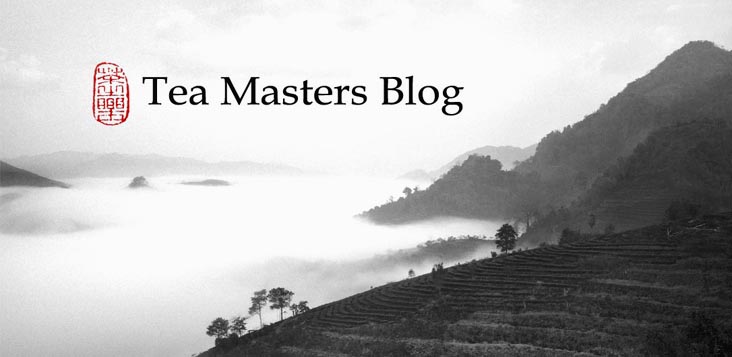Last weekend, I have participated in this HUGE tea Expo in Sichuan Province, China.
These 3 pictures show the main area of the event on the first floor. This represents only a third of the total space of the expo! The second floor and another hall were showcasing more tea and teaware companies!
Local companies and big Chinese tea brands had stands that are bigger than most tea stores.
These big stands always had long tables and young ladies preparing the tea (with a teapot and a pitcher). You would easily feel lost in such a venue...
My booth, on the other hand, was literally empty when I arrived. Even the table and the chairs were missing! Some other stand had taken them, but my wife managed to get them back. So, I decided that the table would be used to show our teas and that I would brew on the floor.
We also got creative with the decoration. I figured that since most tea stands were big and richly decorated, we would stand out if we remained sober and elegant. Let's turn our small size into a strength!
This friendly police guard was the first local Chinese to be curious about our stand! China is very much a police state and it felt good to have him as a new tea friend!
 |
| A Yunnan Province tea exhibitor |
The stand also proved quickly very popular with my neighboring tea stands. This lady from Yunnan had given us some tape to display my postcards on the walls of my booth. I later helped her with attaching her big posters in her booth. This is how hers looked like:
The entrance to the Expo was free and the public was very mixed. Young and old, poor and rich, farmers and city people... The visitors my booth attracted were mostly young and university graduates, though! The students didn't have much money to spend. My chaxi seemed very expensive to them. Actually, I used a gaiwan and these
porcelain cups. I didn't bring my tetsubin or silver kettle since it was too heavy or fragile. So, my main tea making equipment is very affordable. Even the
Chabu I used for decoration is less than 40 USD!
 |
| Chinese students |
More important than money is knowledge and creativity at the service of tea and beauty!
 |
| More Chinese students |
Not everyone was comfortable sitting on the floor, though. I explained that this is how I drink tea at home. When you're on the floor, you don't need to worry that something will fall down. Also, since you're in a similar position than when you meditate, the tea brewing is also most likely to give you the same benefits as a meditation session.
The space of the Chaxi is naturally limited to the distance of what you can grab with your hands without moving your position. A 10 meter long tea table might look cool, but your arms can only reach 1 meter on each side, so that 2 meters is all you need. What matters is how you organize this limited space so that your tea becomes a pleasant and meaningful experience.
 |
| The Expo organizers |
On the first day of the expo, I used green plants that I had picked while walking to the Fuhu temple on Mount Emei. I wanted to connect this feeling of Nature and Beauty on my Chaxi
 |
| Fuhu temple, Mount Emei |
The temple blends with forest.
 |
| Fuhu temple, Mount Emei |
The bald guy below understood my explanations. He said that my Chaxi is much more natural and comfortable than what he saw elsewhere. Another guest in this group wondered if it was worth it to spend so much effort on the Chaxi. I agreed that this only makes sense if you are preparing a very good and enjoyable tea. The actual tea experience is still what should drive us. My
spring Alishan qingxin Oolong was very well received. Everybody in China has heard about Alishan. And since people in Sichuan drink mostly local green tea, they found the fresh, unroasted High Mountain Oolong very powerful and fragrant. It's a very good value and we sold a lot of them. I even sold some
Lishan and a 150 gr pack of
Da Yu LIng!
 |
| More Expo organizers |
During peak hours, there were people standing around the booth to see the only foreign guy who was brewing tea!
On the second day, I switched to this
gorgeous Chabu and used freshly fallen leaves to show my enthusiasm and warm feelings for this event. It was really very satisfying to meet so many tea lovers and see the happiness I could bring with my Chaxi and brewing...
Even local tea house and tea store managers came to discuss possible cooperation with
Tea-Masters! (The last day, I talked to a Taiwanese tea boutique lady who also had a booth in the same alley. She said that, like most Taiwanese booths, she hardly sold anything on the Expo!)
Even this professional teapot makers from Yixing who came to this Expo loved my Chaxi and were so glad to be photographed in it with her teapot!
 |
| Yixing teapot maker |
A friend of hers, also an Yixing teapot maker, liked her picture so much that she also wanted to have her own photograph! You can also see that I made Teaparker's book about Chaxi, Mandala part of my Chaxi! What I have learned with him in over 13 years has really helped make this event a success!
 |
| Yixing teapot maker |
But nothing can compare to the beauty of an old Chinese temple at sunrise:
Especially when drinking
old raw puerh under the moon...






































































